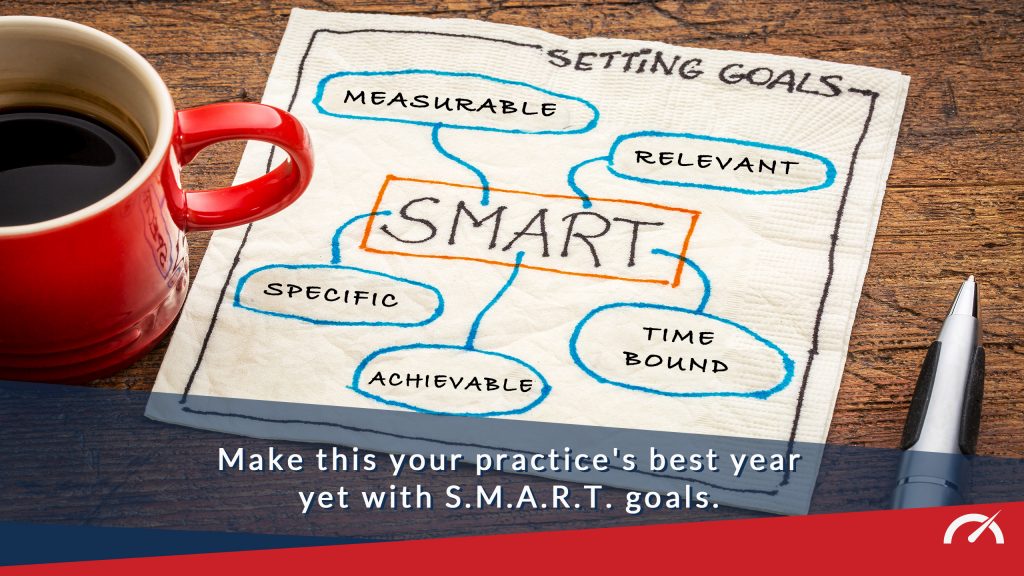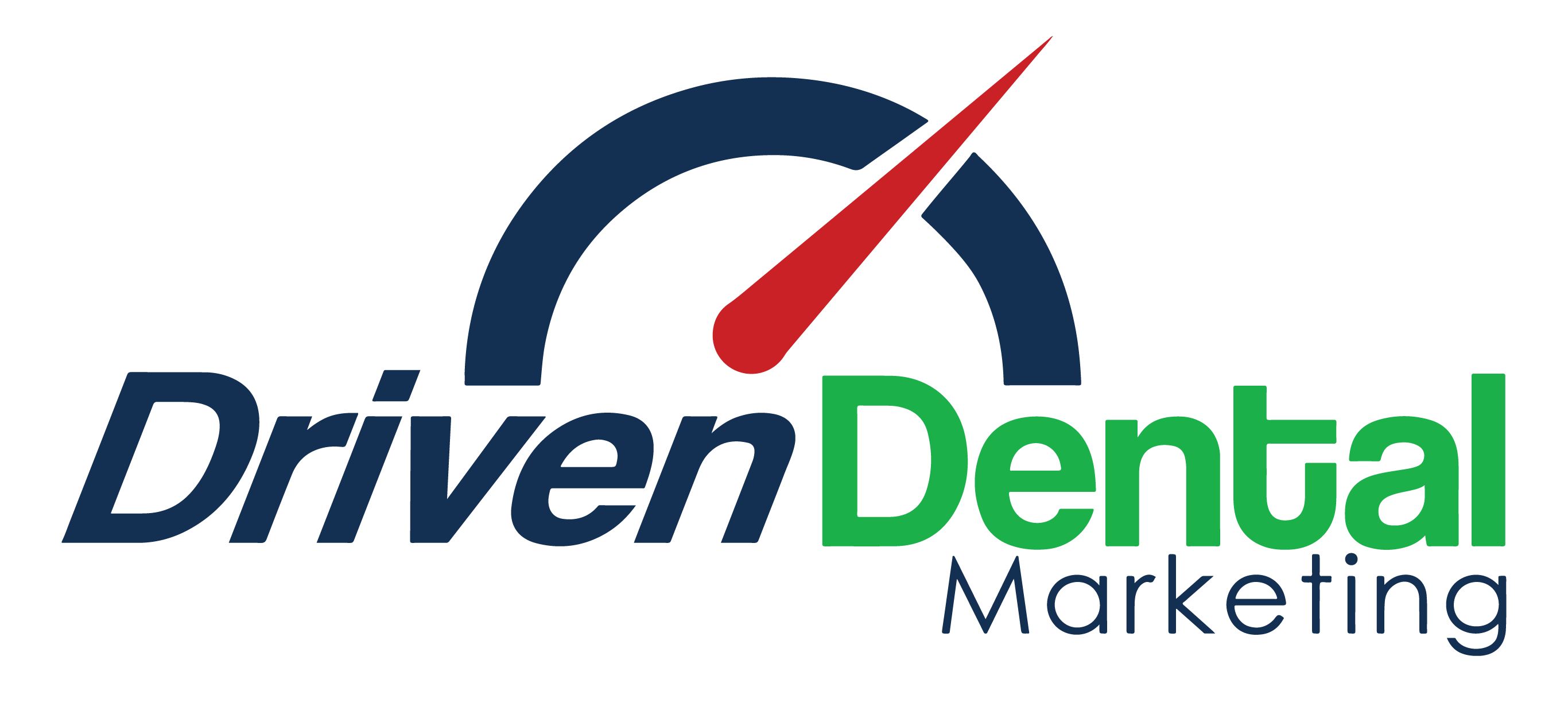French writer and journalist Antoine de Saint-Exupéry famously said, “A goal without a plan is just a wish.” As we near the end of 2020, this quote is timely for many dental practice owners who are setting goals for 2021.
Many people set goals toward the end of each year, only a small percentage of people actually achieve those goals. In helping hundreds of practices set — and achieve — big, bold practice goals, we have observed two actions that separate the practices that achieve goals from those who don’t.
Here are the two steps to take if you want to set big practice goals you can actually achieve in 2021.
Start by setting only S.M.A.R.T. practice goals.

When setting goals, focus on doing so using the S.M.A.R.T. acronym. While the term “S.M.A.R.T goals” is often referenced, little is understood about the importance of each of the letters in the acronym to achieving success. As discussed below, together, creating S.M.A.R.T. goals helps you set goals that give you a very specific destination for your practice. It also gives you a much clearer vision of what you need to do to achieve your goal. In fact, if you don’t set goals using the S.M.A.R.T. acronym, what you set really isn’t a goal at all—it’s more of a wish.
S.M.A.R.T. Goals For Dental Practices
Goals That Are Specific, Measurable, Achievable, Relevant, And Time-Bound
While the concept of setting S.M.A.R.T. goals for your dental practice seems simple, the devil is in the details. For example, wanting higher profits is technically specific but it would not qualify as a specific goal in the context of the S.M.A.R.T. acronym, for reasons we share below. Similarly, generating $2 million in profits next year is achievable for some practices but not for others. Thus, that goal might be achievable for someone else but not for you.
The steps in this post will help you set true, S.M.A.R.T. goals for your practice in 2021 so you can make 2021 your best year yet. Walk through these steps to set big, S.M.A.R.T. goals for 2021.
Setting specific goals for your practice.

Setting specific goals is critical to being able to achieve them. By “specific,” we mean your goal needs to be narrowly defined so you know how to achieve it. Ask yourself, “Does this goal suggest what my next step needs to be?” If it doesn’t, it’s possible that your goal is not specific enough.
The more specific your goal is, the easier it will be to achieve it. For example, assume you want to grow a dental implant practice in 2021. If you’re not currently placing implants, “start placing implants in 2021” would be a specific goal that suggests what you need to do to achieve it. Maybe you need clinical training. Maybe you need dental implant marketing in place. Your goal is specific because it suggests what you need to do to achieve it.
But what if you’re currently placing implants and want to grow your implant practice? You could set a goal to “grow your implant practice,” but that’s not very specific. It only vaguely suggests what you need to do. A goal to “double” your implant practice would be a much more specific goal.
Setting measurable goals for your practice.

After setting a goal that is specific enough to suggest the steps you need to take to achieve it, ask yourself whether it is measurable. Your goal has to be something that can be objectively measurable. It has to be something a neutral third party can come in and verify.
When you set your goal, ask yourself “Could a third party come in and tell us if we are on track?” and “Would a third party be able to tell when we hit the goal?” If you can’t set key performance indicators, or KPIs, that demonstrate progress, your goal is likely not measurable. In addition to setting KPIs, measurable goals tell you what resources you need to allocate to achieve your goal. After setting your goal, list out the KPIs that help you demonstrate progress and success. Your specific KPIs will depend on your goals. But if you can’t identify KPIs, you likely need to make your goal more measurable.
Let’s continue the “grow your implant practice” example. You could achieve your goal by increasing implant revenue by 1%. Or, you could achieve it by seeing one additional implant patient, even if your implant revenue dropped because you had more small cases and fewer big cases. You could technically “hit” your goal without actually achieving what you really had in mind when you set it.
A much better goal would be to “double implant revenue.” That gives you much more direction. It lets you know whether you are on track throughout the year. It suggests what resources to allocate to growing your implant practice. And it lets you know exactly when you achieve your goal. In that case, your KPIs could include the number of implant leads generated, how many patients are coming in for larger cases, and more.
Setting achievable goals for your practice.

The first two steps of setting smart goals set your target. These next two steps ensure it is something that will work in your practice.
Once you have made your goal specific and measurable, ask yourself whether it is achievable. Is it something you can actually achieve in your practice? Do you have the time and resources available to achieve the goal? Do you have a team that could help you achieve the goal if you gave them the right tools and training? If your answers to these questions are yes, your goal is achievable. If not, another adjustment might be necessary.
Continuing our example, if you are the only doctor and already overwhelmed with your workload, doubling implant revenue might not be achievable this year without making other changes in your practice. This is important because it opens up the possibility that there are hidden constraints in your business holding you back. Only if you are willing to make those changes is that goal is achievable for your practice.
STOP GENERATING LEADS, GET PATIENTS INSTEAD
Stop chasing unqualified leads and wasting your valuable chairtime. Learn how to fill your operatories with patients who are pre-qualified and serious about moving forward with your high-value treatment.
Setting relevant goals for your practice.

The “R” in S.M.A.R.T. is often referred to as “realistic.” While having realistic goals is important, it’s really duplicative of “attainable.” A more helpful approach is to make sure your goal is relevant. In the context of setting S.M.A.R.T. goals, relevant means that achieving it is worth the effort. Achieving the goal must help you get closer to your big vision for your practice, finances, lifestyle, and impact.
Setting a relevant goal helps push you and your team members through the inevitable adversity that will arise. It makes your goal about more than just hitting numbers. It makes it about a deeper, more important impact—on you, your practice, your team members, and your patients.
With our example, ask yourself why it’s so important to double your implant practice. How many lives could you change if you doubled your implant practice? How many hours would it free up per week for you to see your family if you didn’t have to rely on drilling and filling to make money? And how rewarding would it be for your team to transform people’s lives?
When you and your team know why hitting your goal is relevant to your shared goals, everyone will be more motivated to achieve it.
Setting time-bound goals for your practice.

Parkinson’s Law tells us that “work expands so as to fill the time available for completion.” That’s why it’s so important to set a deadline for achieving your goal. If you do, the work needed to achieve it will be more likely to get done. Without a deadline, work expands into infinity and never gets done.
Importantly, a deadline also helps create accountability. To do so, make your goal public. Let people know each element of the S.M.A.R.T. acronym and how you are investing to help everyone achieve it. Consider getting a coach to help give you and your team feedback and troubleshoot problems. Or, join a community of business owners or other dental professionals to create a broader support network. You could even do all of these things to really supercharge your progress.
Our example of doubling implant revenue in 2021 has a deadline, 2021. It also suggests other, smaller S.M.A.R.T. goals that help us achieve the big goal. For example, you could set a goal to get everyone trained by the end of Q1 2021. You could set a goal to choose an implant marketing partner by the end of May 2021. Or, you could set a goal to outsource implant lead prequalification by the end of Q2 2021 to allow you to allocate more time to placing implants and less time to talking with leads who aren’t ready to move forward.
When you work with Driven Dental Implant Marketing, we can prequalify leads for you and include coaching and a supportive community for you. We know how important it is for practices to set S.M.A.R.T. goals and have coaching and a supportive community on their side.
Make a plan and execute.

You could have the “S.M.A.R.T.est” goals in the world but they won’t do you any good if you don’t take action. The good news if you followed these steps to set your goals, you will understand exactly what steps you need to take. You just have to start taking them.
We suggest identifying one team member to be responsible for managing each goal. This helps avoid the all-too-common problem of each person thinking someone else is responsible for taking the next step. Create a timeline for them and empower them to follow-up with the people who need to take action. In addition, empower them to identify ways to leverage resources through delegation or outsourcing.
For example, to double your implant revenue in 2021, you likely need proven dental implant campaigns to attract a steady stream of implant patients to your practice. One way to make that happen is to train a team member to place ads. While possible, that can be time consuming and expensive. Many practice owners find it to negatively impact their practice. Between having to stay up-to-date on the latest dental marketing strategies and taking time away from other practice tasks, it can be very costly to try to keep such a specialized task in-house.
That’s why many practices outsource implant marketing to a marketing partner they can trust. At Driven Dental Implant Marketing, we know how to generate a consistent flow of prequalified dental implant leads. We even hired and trained a team of industry veterans, called Virtual Patient Advocates, or VPAs. Our VPAs to prescreen and prequalify leads for clients who not only want to outsource marketing but also want to free up practice resources to place more implants by having a team prescreen leads and only send patients ready, willing, and financially able to move forward. To learn more about how we can help you achieve your implant practice goals for 2021, book a strategy call with us today.
If you would rather watch a video summary of this blog article, please watch here.
